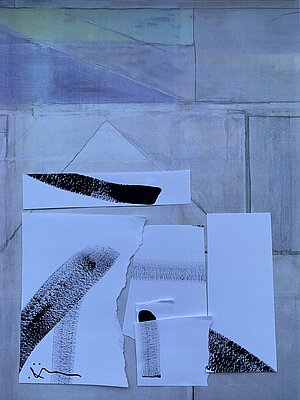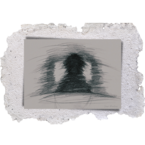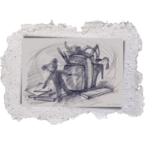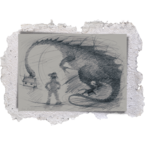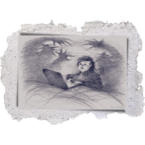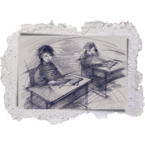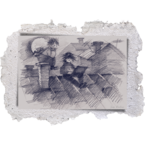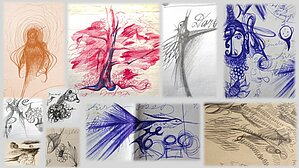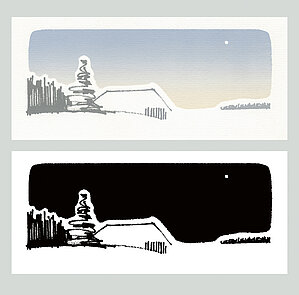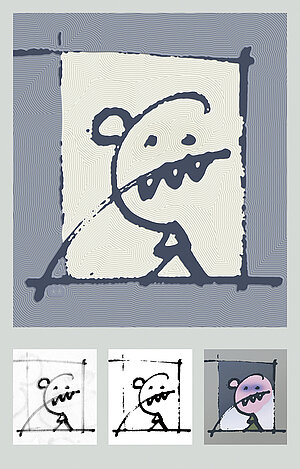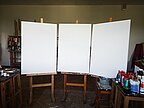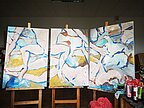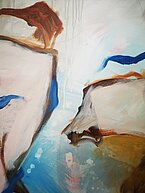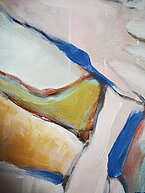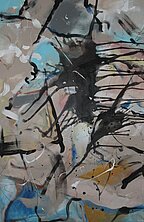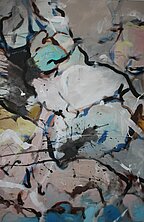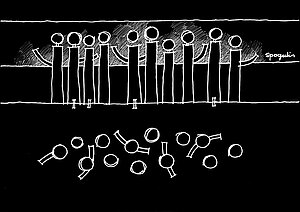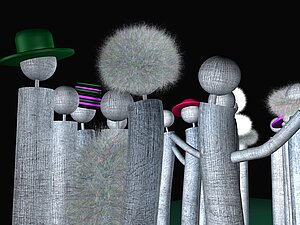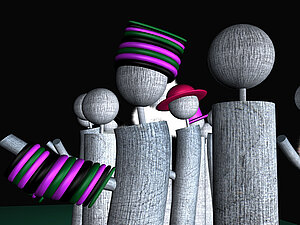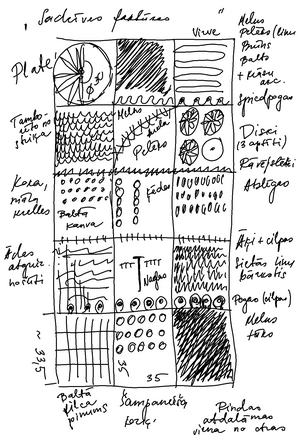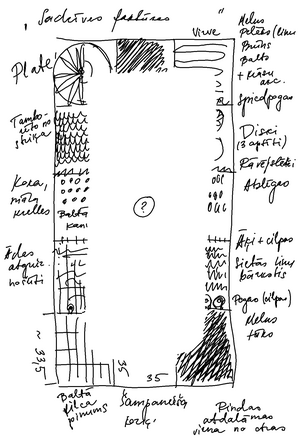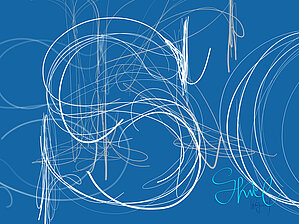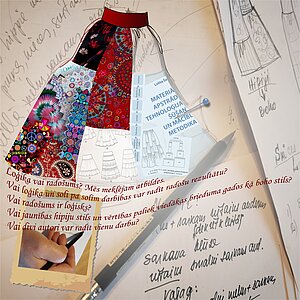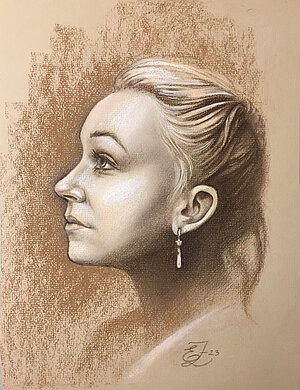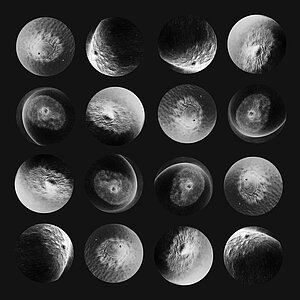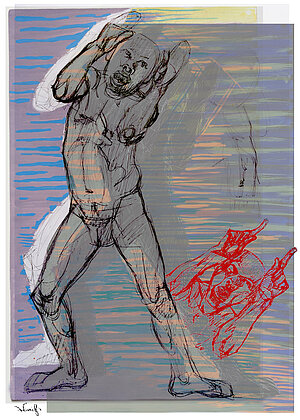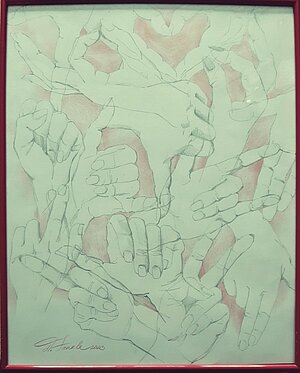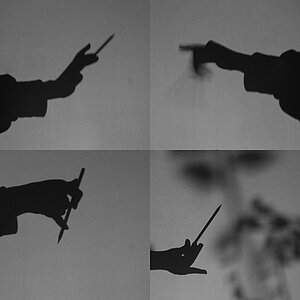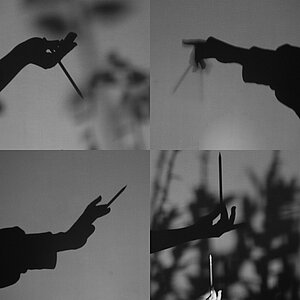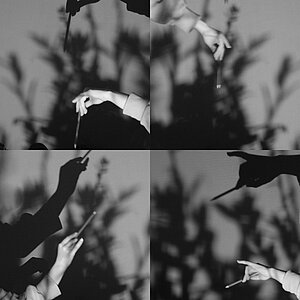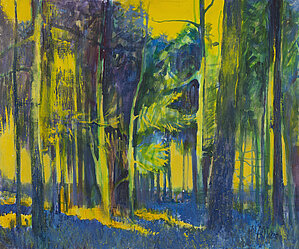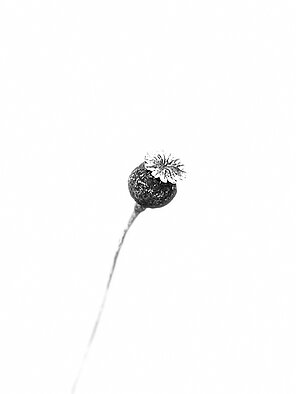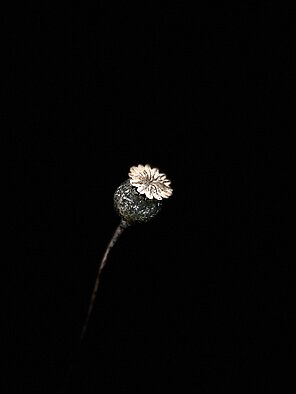Izstāde "Skices anatomija / Anatomy of a Sketch"
Skicēšanai var būt dažādi iemesli – fiksēt novērojumu vai iespaidu, studēt kāda objekta uzbūvi vai kustību vai “noķert” ideju, lai izmantotu to vēlāk. Māksliniekam skice parasti ir sagatavošanās kaut kam lielākam un paliekošākam. Tā ir šķietami īslaicīga epizode darba procesā, kas palīdz domāt par iecerēto darbu, virzīt domas vajadzīgajā virzienā un izmēģināt variantus. Īslaicīgums ir mānīgs, jo pāris minūtēs tapusī skice var būt vairāku dienu, mēnešu vai pat gadu domāšanas rezultāts. Tas ir brīdis, kad ideja materializējas un kļūst redzama.
Skice ir kā dialogs starp mākslinieku un viņa ieceri. Autors konfrontē sevi ar ideju, lai, ieraugot to, spētu iet tālāk – realizēt to iecerētajā materiālā, pārveidot vai pilnībā atmest kā nederīgu un sākt visu no jauna.
Panākt ātruma, viegluma un vienkāršības iespaidu – tas māksliniekam var būt viens no grūtākajiem uzdevumiem. Dažreiz skices top ilgāk un varbūt pat kļūst par radošā procesa mērķi, nevis starpposmu. Arī mainoties kontekstam, skice var kļūt pašvērtīga.
Skice nereti ir arī saziņas līdzeklis. Kad verbālā valoda mūs ierobežo, ķeramies pie vizuālās – skaidrojam to, ko ar vārdiem nespējam.
Šī izstāde ir ieskats radošā procesa aizkulisēs – Latvijas Universitātes (LU), Daugavpils Universitātes (DU), Liepājas Universitātes (LiepU) un Rēzeknes Tehnoloģiju akadēmijas (RTA) docētāji ir piekrituši dalīties ar saviem darba materiāliem.
Sketching can be done for many reasons – to record an observation or impression, to study the structure or movement of an object, or to "catch" an idea to use later. For an artist, a sketch is usually a preparation for something more significant and lasting. It is a seemingly temporary episode in the working process that helps to think about the work, move thoughts in the right direction, and try out options. The brevity is deceptive because a sketch that takes a few minutes can result from days, months or even years of thinking. This is the moment when an idea materialises and becomes visible.
A sketch is like a dialogue between the artist and his idea. The artist confronts himself with the idea so that, when he sees it, he can move on – to realise it in the conceived material, modify it, or discard it entirely as useless and start again.
Achieving an impression of speed, lightness and simplicity can be one of the most challenging tasks for an artist. Sometimes sketches take longer to develop and become the goal of the creative process rather than an intermediate stage. Also, as the context changes, the sketch can become valuable in its own right.
A sketch is often also a means of communication. When verbal language limits us, we turn to the visual – explaining what words cannot.
This exhibition is a glimpse behind the scenes of the creative process – lecturers from the University of Latvia (LU), Daugavpils University (DU), Liepāja University (LiepU), and Rēzekne Academy of Technologies (RTA) have agreed to share their work materials.
Ingrīda Irbe (LU). SKICE ABSTRAKTAI GLEZNAI / SKETCH FOR AN ABSTRACT PAINTING
Pie skiču veidošanas un ideju attēlošanas uz papīra vai audekla esmu pieradināta no desmit gadu vecuma, sākot profesionālas studijas mākslā J. Rozentāla mākslas vidusskolā. Arī studijās Mākslas akadēmijā skicējām, bet jau daudz mazāk.
Interesants pavērsiens skiču veidošanā man notika, studējot Amerikā, Humbolta universitātē. Tur es biju vienīgā kursā, kura veidoja skices pirms abstraktu lielformāta darbu gleznošanas.Tolaik mani interesēja ekspresīvie abstrakcionisti, īpaši Ričarda Dibenkorna darbi. Izmantoju grāmatas, lai izveidotu ļoti daudz mākslinieka darbu A4 kopijas, un tās man kalpoja idejas skiču veidošanai gan kā iedvesmas avots, gan kā skices pamatne vienlaicīgi. Šī darbošanās ļoti patika maniem pedagogiem un kursa biedriem, tāpēc studiju gada laikā nācās dalīties pieredzē ar daudziem, to pārņēma citi studenti un izmantoja savu abstrakto darbu radīšanas procesā. Vienu tādu paraugu es izveidoju šogad un piedāvāju izstādei.
I have been accustomed to making sketches and representing ideas on paper or canvas since I studied art professionally from the age of 10 at the Art High School and later at the Art Academy.
An interesting turning point in sketching happened when I was studying at Humboldt State University in California, where I was the only one in the course who made sketches before painting large–scale abstract works. At that time, I was interested in the expressive abstractionists, especially the works of Richard Diebenkorn. I made a lot of A4 copies of the artist’s works and they served as a basis and source of inspiration for creating small idea sketches. My teachers and fellow students liked this activity very much, many adopted it and used it in the process of creating their work. I created one such sample and offered it for the exhibition.
Inese Dundure (RTA). DATORBĒRNS / COMPUTER CHILD
Ilustrācijas veidotas pēc Leontīnes Apšenieces dzejas bērniem motīviem.
Ilustrāciju sērija izpildīta ar grafīta zīmuli uz akvareļpapīra. Brīvs grafīta švīkājums pa raupjas faktūras papīru piešķir ilustrācijām skičveida kopiespaidu. Vienkāršs grafisks zīmējums vai monohroma skice ir pašpietiekama, lai nestu sevī stāstu un kļūtu par ilustrāciju.
Sākumskolas bērniem domātie dzejoļi stāsta par mūsdienu bērnu skolas gaitām, kur liela vieta ir datoram un citām digitālām lietām. Ilustrācijas ataino skolēnu attieksmi pret ikdienas norisēm skolā un katra atsevišķa bērna attiecībām ar savu datoru un tajā slēpto virtuālo pasauli.
Illustrations are based on the motifs of Leontine Apšeniece’s poetry for children.
The series of illustrations is made with graphite pencil on watercolour paper. Free strokes of graphite on rough-textured paper give the illustrations an overall sketchy feel. A simple graphic drawing or monochrome sketch is enough to carry a story and become an illustration.
The poems intended for primary school children tell about the progress of modern children’s schooling, where computers and other digital things have a big place. The illustrations depict the students’ attitude towards the daily events at school and the relationship of each child with his computer and the virtual world hidden in it.
Austra Avotiņa (LU). MARGINALIA VITAE
Skice uz lapas malām ir kā spogulis, kā dzīve. Skice ir doma, tā ir vīzija, kas atspoguļo dzīves patiesību. Skice var būt ātra, nejauša, vairāk vai mazāk saprotama, bet tā vienmēr ir patiesa.
A sketch on the margins of a page is like a mirror, like life. A sketch is a thought, it is a vision that reflects life’s truth. A sketch can be quick, accidental and more or less understandable, but it is always true.
Aivars Plotka (LU). PERSONA / PERSON
Skice ir domas, tēla vai situācijas vizualizācija, tiecoties saglabāt un neaizmirst gaistošo. Mirkļa logotips, ja paveicas. Domas ne vienmēr nonāk “uz papīra”, taču brīži, kad tas notiek, sniedz prieku un labu tiesu jautrības.
A sketch is a visualization of a thought, image or situation, striving to preserve and not forget the vanishing. Logo of the moment, if lucky. Thoughts don’t always end up “on paper”, but the moments when it happens bring joy and great fun.
Žanna Vērdiņa (DU). Triptihs DOMAS. EMOCIJAS. REAKCIJA / Triptych THOUGHTS. EMOTIONS. REACTION
Glezna dzimst no idejas. Ir iedvesma, ir ideja. Tad skice. Manā gadījumā ir grūti pieturēties pie skices, jo vienmēr viss iznāk citādi. Dažreiz ir grūti paredzēt rezultātu, un tas padara to vēl interesantāku.
A painting is born from an idea. There is inspiration, there is an idea. Then a sketch. In my case, it is difficult to stick to the sketch, as everything always turns out differently. Sometimes it is difficult to predict the result, which makes it even more interesting.
Ilze Biezā (LU). MANEKENI / MANNEQUINS
Skicēšana ir ātra un viegla iespēja fiksēt un pārbaudīt autora domu.
Manekenu ideja ir attēlota ar roku zīmētā skicē. Idejas vizualizācija krāsās un materiālos veidota 3ds Max programmā.
Manekeni ir izmantojami cepuru un citu apģērba piederumu eksponēšanai veikalā vai izstādē. Tos paredzēts izgatavot pēc individuāla pasūtījuma, no sausa lapu koka. Koka elementus plānots savienot ar metāla detaļām. Beigu apdare – pelēkas krāsas tonējums, pārklāts ar pusmatētu laku.
Sketching is a quick and easy opportunity to capture and test the author’s thought.
The idea of mannequins is depicted in a hand-drawn sketch. The visualisation of an idea in material and colour is created in the 3ds Max programme.
Mannequins are used to demonstrate hats and other clothing accessories in a store and exhibition. They are designed to be made from dry leafwood to custom order. Metal parts are planned to be used to connect wooden elements. Finish: grey toning coated with semi-matt varnish.
Austra Celmiņa-Ķeirāne (LU). IESPĒJAS / OPPORTUNITIES
Skicēšanai digitālajā planšetē ir daži trūkumi – nav iespējams izmantot tik daudzveidīgu instrumentu klāstu, nav iespējams iegūt tādas līniju un toņu nianses, un nav iespējams izjust zīmuļa pieskārienu dažāda papīra virsmām. Tomēr ir arī savas priekšrocības – dažu sekunžu laikā skici var dublēt, transformēt un izdzēst no tās atsevišķas vietas. Savā ziņā tas dod lielāku brīvību un ietaupa laiku.
Darbu, kas tapa no šīs skices, var atrast šeit: https://www.ppmf.lu.lv/par-mums/radosa-darbiba/izstades/nagla/.
Sketching on a digital tablet has some drawbacks – you can’t use such a wide range of tools, you can’t get the nuances of line and tone, and you can’t feel the touch of the pencil on different paper surfaces. However, there are advantages – you can duplicate, transform and erase parts of a sketch in seconds. In a way, it gives more freedom and saves time.
The work that resulted from this sketch can be found here: https://www.ppmf.lu.lv/par-mums/radosa-darbiba/izstades/nagla/.
Agris Dzilna (LU). SKICE / SKETCH
Ar skicēšanu, kad ar to saprot uzmetumu veidošanu mākslinieka vai dizainera darbam, es nodarbojos ļoti maz. Parasti veidoju jau gatavas darba detaļas. Pēc tam tās transformēju, kārtoju un veidoju gala kompozīciju. Darbā, ko redzat, katra līnija pretendē uz gatava elementa lomu un ir vienotas kompozīcijas sastāvdaļa. Pati kompozīcija vizualizē skici kā pašvērtību.
If sketching means making rough sketches for an artist’s or designer’s work, I do very little of that. I usually make finished parts of the work. Then I transform them, sort them, and make the final composition. In the work you see, each line takes the role of a finished element and is part of a single composition. The composition itself visualizes the sketch as a self-value.
Paula Vītola (LiepU). VIĻŅI–GAISMAS–ĒNAS / WAVES–LIGHTS–SHADOWS
Attēlos redzama autores personālizstādes “Viļņi–gaismas–ēnas”, kura norisinājās 2020. gadā RIXC galerijā, dokumentācija (attēli – Kristīne Madjare). Izstādē apskatāmie darbi bija mākslinieciski eksperimenti ar fotoakustikas fenomenu – skaņas iegūšanu ar gaismu.
Izstādē bija apskatāmi dažādi prototipi un instrumenti skaņas radīšanai ar gaismu, kuri izgatavoti, izmantojot rotējošus objektus, vibrējošu auklu, stroboskopus un krāsainas gaismas. Izstāde tika veidota kā radošā darbnīca, kurā apmeklētāji bija aicināti rotaļīgā veidā mācīties, eksperimentēt un pētīt dažādas skaņas. Skaņas iegūšanas process ar kustīgajām ēnām un mirgojošām gaismām ir ilustrēts ar skicēm, kuras ir nozīmīga daļa no izstādes, ļaujot apmeklētājiem iepazīt eksperimentu tehniskos procesus.
Vairāk informācijas un video dokumentācija no izstādes: https://paula.mplab.lv/works/.
Documentation of the exhibition “Waves–Lights–Shadows” which took place in 2020 in RIXC gallery (photos: Kristīne Madjare). The exhibition’s works are artistic experiments with photoacoustic phenomena, which means generating or transmitting sound using light.
The exhibition displayed various prototypes and instruments for generating sound that were made from vibrating strings, rotating objects, stroboscopes and coloured lights. It was set up as an experimental workshop allowing visitors to learn, explore and create through the playful process. The process of various ways how the sound is generated with light using moving shadows or flickering light is illustrated with sketches that are a part of the exhibition to help visitors understand the technical process behind the experiments.
More information and video documentation of the process and the exhibition can be found at: https://paula.mplab.lv/works/.
Lolita Šelvaha (LU), Inguna Ojere. SKICES ANATOMIJA / ANATOMY OF A SKETCH
Mēs meklējam atbildes uz jautājumu: loģika vai radošums? Vai loģika un “soli pa solim” darbības var radīt radošu rezultātu? Vai radošums var būt loģisks?
Vai jaunības izaicinošais hipiju dzīves stils un vērtības paliek viedākas brieduma gados? Vai boho stils ir mierīgāks un harmoniskāks? Vai horizontālo volānu svārkus var šūt arī savādāk?
Vai divi autori var radīt vienu darbu? Vai abi var sasniegt savu mērķi un radīt savu risinājumu? Vai viena skice var radīt atšķirīgus dizaina produktus? Vai ideju izmaina tās tehniskais risinājums?
Ja vienam ir ideja, otram tehniskais risinājums: kurš zaudē, kurš iegūst?
We are looking for answers to the question: logic or creativity? Can logic and step-by-step actions lead to creative results? Can creativity be logical?
Do the defiant hippie lifestyle and values of youth remain wiser in maturity? Is the boho style more peaceful and harmonious? Can horizontal ruffle skirts be made differently?
Can two authors create one work? Can both achieve their goal and create their solution? Can the same sketch lead to different designs? Does the technical solution change the idea?
If one has the idea, the other the technical solution: who loses, who gains?
Diāna Apele (RTA). PLANĒTAS / PLANETS
Pēdējie notikumi, kas globālā mērogā ietekmē visus planētas iedzīvotājus, ir spilgti pierādījuši savstarpējo cilvēku sasaisti. Tieši šajā ne tik vienkāršajā laikā arī tapa ideja vairākiem konceptuālajiem mākslas darbiem (darbs “Dzimtas piens” pagājušajā gadā tika izstādīts divās Latgales reģiona mākslinieku konkursa izstādēs – Daugavpils Marka Rotko mākslas centrā un Latgales Kultūrvēstures muzejā).
Mākslas darbu sēriju tapšanas process bija ļoti intriģējošs, intīms un neierasts, arī humora pilns. Šajā drosmīgajā fotosesijā piedalījās 12 dzimtas sievietes no 14 līdz 78 gadu vecumam, gūstot līdz šim vēl nebijušu pieredzi. Darba procesā tapa ļoti daudz fotografikas skiču, konkrētajā darbā izmantotas četras.
Sieviešu krūtis mākslas darbos pārvēršas par neizdibināmām planētām, fiksējot gan pārmaiņas, kas skārušas viņu ikdienas dzīvi, gan to nemainīgās vērtības, kas gadu gaitā apvieno dzimtu un pasauli kopīgā DZĪVES MĀKSLAS VALODĀ. Lai šajā gadā, dodoties nezināmajā, visu zemeslodi apspīd saule, neizsīkst dzimtas piens un neapstājas kustībā esošās planētas!
Recent events that affect the population of the planet on a global scale have vividly demonstrated these strong interconnections between people. It was during this not-so-simple time that the idea for several conceptual works of art was born (the work “Family Milk” was exhibited last year in two exhibitions of the Latgale regional artist competition – Daugavpils Mark Rothko Art Center and Latgale Cultural History Museum).
The process of creating a series of artworks was very intriguing, intimate and unusual, also full of humour. 12 women from 14 to 78 years of age took part in this daring photo session, gaining an unprecedented experience. A lot of photographic sketches were made during the work process (four are used in this specific work).
Women’s breasts turn into unfathomable planets in works of art, capturing both the changes that have affected their daily lives and their constant values, which over the years unite the family and the world in a common ART LANGUAGE OF LIFE. Let the sun shine on the whole globe this year, let the family’s milk not run out and the planets in motion not stop!
Natālija Brokāne (RTA). SKICĒTĀJS / SKETCHER
Mākslinieks/skicētājs – darba apraksts – cilvēku, priekšmetu, situāciju, noskaņu skicēšana ar zīmuli, kā arī citās tehnikās. Prasības kandidātiem – spēja strādāt un domāt patstāvīgi un rezultatīvi, spēja aktivizēt, aizraut, pārņemt iniciatīvu, motivācija darbam, būt vispusīgam, talantīgam, vienmēr radošam un dzīvespriecīgam, būt pamanāmam.
Vai kāds ir aizdomājies, cik sarežģīts un neparasts ir liktenis māksliniekam/skicētājam? Tev nav brīvdienu, Tu nevari būt bez mūzas, Tu nevari bēdāties, Tev vienmēr ir jāattīstās un jāpilnveidojas, Tev jābūt pieprasītam un atzītam. Bet Tev ir liela dzīves dāvana – Tu spēj saskatīt un saredzēt to, ko citi nespēj. Tu māki apturēt mirkli un iemūžināt to tikai ar viena zīmuļa palīdzību! Tu proti redzēt un sapņot!
Artist/sketcher - job description - sketching people, objects, situations, and moods with a pencil, as well as in other techniques. Requirements for candidates – the ability to work and think independently and effectively, the ability to activate, excite, take initiative, motivation to work, to be versatile, talented, always creative and cheerful, to be noticeable.
Has anyone thought how complicated and unusual the fate of an artist/sketcher is? You don’t have holidays, you can’t be without a muse, you can’t be sad, you must always develop and improve, and you must be in demand and recognized. But you have a great gift of life – you can see what others can’t. You know how to stop the moment and capture it with just one pencil! You know how to see and dream!
Agata Muze (LU). GAISMĒNAS MEŽĀ I / LIGHT AND SHADE IN THE WOOD I
Pastaigas dabā arvien ir pastāvīgu jaunatklājumu, bagātīgas daudzveidības piesātinātas. Tajās iespējams gūt plašu sajūtu gammu. Man ir ļoti svarīgi būt dabā, lai gūtu iespaidus, ieraudzītu gleznošanai atbilstošus motīvus, lai tos interpretētu gleznai vajadzīgajā kompozīcijā, atmetot nebūtiskas detaļas un izceļot raksturīgāko.
Es eksperimentēju, atainojot dabas motīvus dažādās gleznošanas stadijās. Dažkārt īstā noskaņa ir panākta, jau tik tikko ieskicējot ainavas aprises. Arī šajā darbā “Gaismēnas mežā” pārspīlēts silti vēsais kontrasts un ātriem otas vilcieniem ieliktie koku ritmi pilnvērtīgi atklāj tveicīgo sajūtu mežā karstā vasaras dienā. Tāpēc šī lielā skice ir arī jau gatavs darbs. To mēģinot padarīt “gatavāku”, pazustu pirmā un intensīvā iespaida efekts.
Walking in nature is always full of constant discoveries, and rich diversity. You can experience a wide range of sensations in them. For me, it is very important to be in nature to get these impressions, to see motifs suitable for painting, to interpret them in the necessary composition for the painting, discarding irrelevant details and highlighting necessities.
I experiment with depicting nature motifs in different stages of painting. Sometimes the right mood is achieved by barely sketching the outlines of the landscape. Also in this work “Light and Shade in the Wood I” the warm-cool contrast is exaggerated and the rhythms of the trees set in quick brushstrokes fully reveal the steamy feeling in the forest on a hot summer day. Therefore, this large sketch is also a finished work. Trying to make it more “complete” would lose the effect of the first and intense impression.

 Akadēmiskais centrs
Akadēmiskais centrs